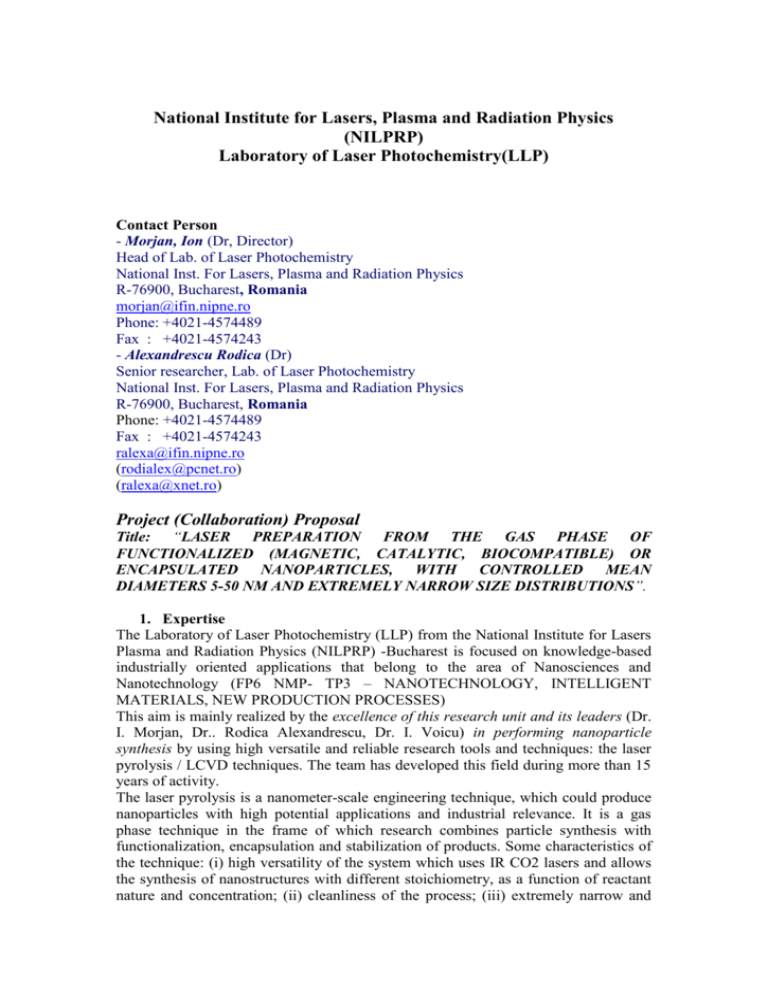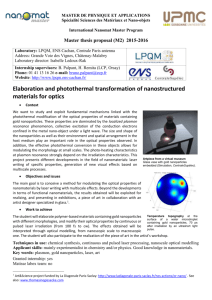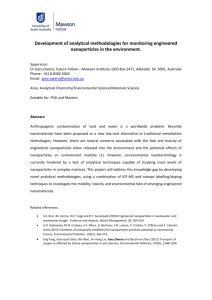National Institute for Lasers, Plasma and Radiation Physics (NILPRP)
advertisement

National Institute for Lasers, Plasma and Radiation Physics (NILPRP) Laboratory of Laser Photochemistry(LLP) Contact Person - Morjan, Ion (Dr, Director) Head of Lab. of Laser Photochemistry National Inst. For Lasers, Plasma and Radiation Physics R-76900, Bucharest, Romania morjan@ifin.nipne.ro Phone: +4021-4574489 Fax : +4021-4574243 - Alexandrescu Rodica (Dr) Senior researcher, Lab. of Laser Photochemistry National Inst. For Lasers, Plasma and Radiation Physics R-76900, Bucharest, Romania Phone: +4021-4574489 Fax : +4021-4574243 ralexa@ifin.nipne.ro (rodialex@pcnet.ro) (ralexa@xnet.ro) Project (Collaboration) Proposal Title: “LASER PREPARATION FROM THE GAS PHASE OF FUNCTIONALIZED (MAGNETIC, CATALYTIC, BIOCOMPATIBLE) OR ENCAPSULATED NANOPARTICLES, WITH CONTROLLED MEAN DIAMETERS 5-50 NM AND EXTREMELY NARROW SIZE DISTRIBUTIONS”. 1. Expertise The Laboratory of Laser Photochemistry (LLP) from the National Institute for Lasers Plasma and Radiation Physics (NILPRP) -Bucharest is focused on knowledge-based industrially oriented applications that belong to the area of Nanosciences and Nanotechnology (FP6 NMP- TP3 – NANOTECHNOLOGY, INTELLIGENT MATERIALS, NEW PRODUCTION PROCESSES) This aim is mainly realized by the excellence of this research unit and its leaders (Dr. I. Morjan, Dr.. Rodica Alexandrescu, Dr. I. Voicu) in performing nanoparticle synthesis by using high versatile and reliable research tools and techniques: the laser pyrolysis / LCVD techniques. The team has developed this field during more than 15 years of activity. The laser pyrolysis is a nanometer-scale engineering technique, which could produce nanoparticles with high potential applications and industrial relevance. It is a gas phase technique in the frame of which research combines particle synthesis with functionalization, encapsulation and stabilization of products. Some characteristics of the technique: (i) high versatility of the system which uses IR CO2 lasers and allows the synthesis of nanostructures with different stoichiometry, as a function of reactant nature and concentration; (ii) cleanliness of the process; (iii) extremely narrow and controlled particle size distribution and (iv) possibility to scale-up the process to a pilot plant. Thus, main objectives of our researches are: - to achieve nanomaterials with predictable composition and structure, control of their properties and performances - characterization of the produced nanomaterials - investigations about their functionality and industrial applications - scaling-up of the process of laser pyrolysis 2. Organization Details Name: National Institute for Lasers, Plasma and Radiation Physics (NILPRP) Laboratory: Laboratory for Laser Photochemistry (LLP) Address: National Institute for Lasers, Plasma and Radiation Physics, Web site: www.infplr.ro Useful link: http://www.nanoforum.org/events/workshop/orals/Morjan1NewTrends.pdf P.O Box MG 36, R-76900, Bucharest, Romania Type: Research; Education; Demonstration Number of Employees: 9 (LLP) – 110 (NILPRP) LLP has obtained excellent results leading to innovative and some outstanding reports in prestigious international journals (more than 60 publications in the last 15 years). The Laboratory is virtually a technology demonstration center, which combines scientific innovation and testing facilities with training and education capabilities and local sustainable development. The laboratory is ready for R&D FP 6 implementation, being able to be a partner in a FP 6 Network of Excellence. LLP includes skilled personnel such as three senior scientific researchers, three scientific researchers (and PhD students), one chemist, two PhD students and one technician. Young researchers experience a current training activity in nanostrucutred materials (synthesis and characterization). The group has not only arrived at a reference status but has also continuously pushed forward the knowledge in the nanoscience area, by developing ambitious and skilled projects which are strongly application-oriented. LLP programs strive to interact with industry and to transfer its technology to industrial users and developers and provide excellently educated graduates and research associates to society. 2.a. Current Research Projects (fields of interest) - The preparation of nanoparticles and nanostructures find its goal in an industrial context, i.e. applications in areas such as health, medical systems (iron and gamma iron oxide nanoparticles with extremely narrow size distributions and mean diameters between 5-10nm, nanocarbons), particles for magnetic tracking and biocompatible nanomaterials (nano-iron embedded in carbon sheets) , chemistry-catalysis (Fe, Ti, Sn nano-oxides and composites), energy saving (nanocarbons and carbon nanotubes for hydrogen storage), optical and environmental applications (Fe, Ti oxides and composites for chemical sensor; polysiloxanes embedded iron nanoparticles for enhanced thermal, electrical, magnetic properties), nanostructures for hard coatings (TiC, CN) and tribological use (MoS)). -The characterization techniques employed for analyzing their properties and imaging their structure (TEM, HREM, SEM, SAED, XRD, IR and Raman spectroscopy, sensing and magnetic properties) - The study of materials phenomena offering new options to their long term us, in order to lead to innovative industrial applications SELECTED PUBLICATIONS - F. Dumitrache et al, “Nearly monodispersed carbon coated iron nanoparticles for the catalytic growth of nanotubes/nanofibres”, Diamond and Related Materials, 2003, in print - R, Alexandrescu et al. “Recent developments in the synthesis of iron-based nanostructures by laser pyrolysis: integrating structural analysis with experimental method”, Solid State Phenomena, 2003, in print - I.Morjan et al. “Nanoscale powders of different iron oxide phases prepared by continuous irradiation of iron pentacarbonyl-containing gas precursors”, Mater. Sci. Eng. C 1020 (2002) 1 -6 - R. Alexandrescu “Synthesis of Carbon Nanotubes by CO2 - Laser-Assisted Chemical Vapor Deposition”, Infrared Phys. Technol. 44 (2003) 43 - S. Martelli “Production Of Iron-Oxide Nanoparticles By Laser Induced Pyrolysis of Gaseous Precursors”, Appl. Surf. Sci. 154-155 (2000) 353 2.b. Former Research Projects - Nanopowders and thin films produced by laser pyrolysis and LCVD techniques: silicon carbide, silicon nitride, Si/C/N nanocomposites, titanium carbide, aluminum oxides and carbides, iron carbides, iron and titanium thin films, carbon nitride nanoparticles and thin films, fullerenes. SELECTED PUBLICATIONS - F. Huisken et al, “Silicon carbide nanoparticles produced by CO2 laser pyrolysis of SiH4/C2H2 gas mixtures in a flow reactor”, Journal of Nanoparticles Research, 1(2), 293-303 (1999) - R. Alexandrescu et al. “Preparation of iron carbide and iron nanoparticles by laser induced gas phase pyrolysis” J. Phys. IV France 9, (1999) Pr8-537-544 - R. Cireasa et al “Influence of Process Parameters on CNx Films Obtained by LaserCVD at Two Wavelenghts”, Carbon, 36, 5-6, (1998), 775 - R.Alexandrescu et al “Synthesis of TiC and SiC/TiC Nanocrystalline Powders by Gas Phase Laser Induced Reactions”, J. Mater. Sci., 32, 5629-5635 (1997) - R.Alexandrescu et al “Preparation of Carbon Nitride Fine Powder by Laser Induced Gas-Phase Reactions”, Appl. Phys. A., 65, 207-213 (1997) I. Voicu et al, ”Effect of SF6 Addition in the Laser Synthesis of Fulerene and Soot, from Benzene/Oxygen Sensitized Mixtures”, Carbon, 36 (1998), 1285-1290 - R.Alexandrescu et al "Nanocomposite Ceramic Powders Production by Laser Induced Reactions", Materials Science and Engineering A, 168, 177 (1993) - E.Borsella et al "Composite Si/C/N Powder Production by Laser Induced Gas Phase Reactions", J. Mater. Res., 7, 8, 2257 (1992) 2c. Resources - Different high-performance laser pyrolysis installations provided with high and medium power CO2 lasers, for specific nano-powder preparation - Characterization devices: IR and Raman spectroscopy, access to TEM, SEM, HREM, EDAX and XRD measurements - Expertise for nanoparticles production, encapsulation, stabilization, handling - Expertise in micro structural characterization of the synthesized nano bodies. 3. Collaboration 3a. Already existing collaboration in European Networks: - EU network of centers of excellence -Interfacial effects, novel properties and technologies of nanostructured materials (acronym: Nanostructured Materials) http://www.unipress.waw.pl/CE/ - "Network of Excellence on Nanoelectronics (Phantoms)", contract Number IST2000-26021 http://www.phantomsnet.com/ - EU Cost Action 523: "Nanostructured Materials" http://cost.cordis.lu/ - National network “NANOMATFAB” 3b-- Bilateral European cooperation with: - Max Planck Institute, Astrophysical Center –Jena (“iron and carbon-based nanoparticles”) - CEA –Saclay, Centre des Atomes, Photons et Molecules (“carbon based nanostructures”) - Institute for Chemical Process Fundamentals of the Czech Academy of Science, Prague (“polymer embedded iron nanoparticles”) - Institute of Materials, Brno (“magnetic properties of iron-based nanoparticles”) - ENEA-Frascati Rome (“SiC –based nanoparticles”) - NATO SfP Project (2000-2003) - Universite de Strasbourg (“carbon embedded nanoparticles and nanotubes”) 4. Research Interests - Industrial production of nanoparticles with different functionalities - Development of nanostructured materials and composites (titanium doped iron oxide, FeO embedded Fe nanoparticles, carbon/Fe nanocomposites, etc - Multifunctional thin films (titanium/silicon carbides, carbon nitrides) - Intelligent biomaterial for tissue repair and regeneration (metallic, ceramic, polymer, composites nanomaterials) - Biocompatible nanocarbons (carbon encapsulated nano iron based particles) : magnetic particles, to provide the biomaterials with the desired functionality. - Tribological compatible nanomaterials (silicon carbide, silicon nitride, titanium carbide, carbon nitride) for automotive and space - New and user-friendly production technologies: through the laser pyrolysis technique, due to its flexibility, high quality, eco-friendly properties for EU industry – the technique creating products with high added value and offering precision at the nanoscale (controlled particle dimensions). - Integration of nanotechnologies in chemical procedures, mastering chemicals and creating high added values – particularly in the field of catalyzing nanooxides (titanium oxides, iron and titanium-doped iron oxides, tin-doped iron oxides) 5. Target: to become a Partner in IP, STREP or NoE new EC instruments, according to the above mentioned research interests. - Target partners: Industrial partners / SMEs / Research organizations and Institutes: Expertise: Nanoparticle mass production from the gas phase, Nanotechnology, NanoBiotechnology, Magnetic nanostructures, Chemical, Catalysis, Sensors, Nanostructured Coatings. -Country: Member States of the European Union, Israel, Switzerland, Associated countries. 6. Keywords: nanoparticles; nanocomposites, functionalised nanoparticles, laser pyrolysis; gas phase synthesis, hybrid materials, new design nanomaterials, flexible manufacturing technologies, high added value products, chemical technologies, magnetic nanoparticles, nanostructured sensors, catalytic nanomaterials






